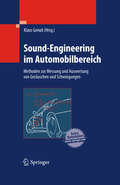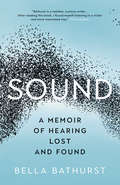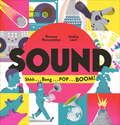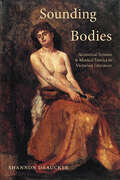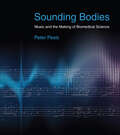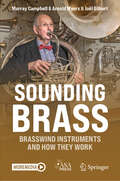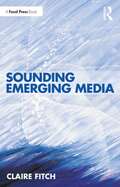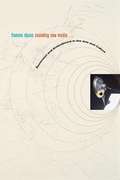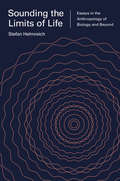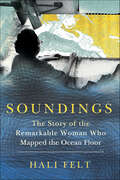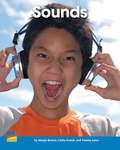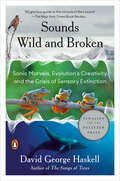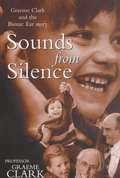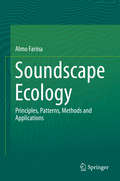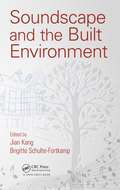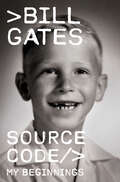- Table View
- List View
Sound-Engineering im Automobilbereich
by Klaus GenuitMit steigenden Kundenansprüchen gewinnen die Fragen unerwünschter Geräusche im Kraftfahrzeug zunehmend an Bedeutung. Sie begleiten Ingenieure im Automobilbereich von der Konzept- bis zur Serienphase. Dabei ist das Thema stets im Kontext weiterer Entwicklungsfelder wie Antrieb oder Aerodynamik zu betrachten. Das Überblickswerk bietet die Möglichkeit, sich schnell in das Thema einzuarbeiten und schnell auf Grundlagen und Details zugreifen zu können. Dabei werden die Themen Fahrzeuginnengeräusche und Fahrzeugaußengeräusche gleichermaßen behandelt.
Sound: A Memoir of Hearing Lost and Found
by Bella Bathurst&“A moving and fascinating book about sound and what it means to be human&” from the Somerset Maugham Award–winning author of The Lighthouse Stevensons (Financial Times). In this surprising and moving book, award-winning writer Bella Bathurst shares the extraordinary true story of how she lost her hearing and eventually regained it and what she learned from her twelve years of deafness. Diving into a wide-ranging exploration of silence and noise, she interviews psychologists, ear surgeons, and professors to uncover fascinating insights about the science of sound. But she also speaks with ordinary people who are deaf or have lost their hearing, including musicians, war veterans, and factory workers, to offer a perceptive, thought-provoking look at what sound means to us. If sight gives us the world, then hearing—or our ability to listen—gives us our connections with other people. But, as this smart, funny, and profoundly honest examination reveals, our relationship with sound is both more personal and far more complex than we might expect. &“Bathurst is a restless, curious writer . . . After reading this book, I found myself listening in a richer and more interested way.&” —The Guardian &“A hymn to the faculty of hearing by someone who had it, lost it and then found it again, written with passion and intelligence . . . terrifying, absorbing and ultimately uplifting.&” —Literary Review &“Bathurst&’s affecting memoir will enlighten and educate.&” —Publishers Weekly &“A memoir of hearing loss and what the author learned . . . through her unexpected recovery from it. A good writer knows material when it presents itself, and Bathurst is a very good writer.&” —Kirkus Reviews
Sound: A Question and Answer Book (Fact Finders)
by Fiona BayrockThe book introduces the concepts of sound waves, vibration, and energy, and presents how humans perceive and produce different sounds
Sound: From Whisper to Rock Band
by Christopher CooperWhat is sound? How does sound move through air and water? Why are some sounds high in pitch and others are low? Investigate the curious world of physical science! Find out for yourself about Sound through experiments that you can do at home. Did you know that some animals hear sounds that you cannot hear? Sound will show you the importance of investigating and understanding the physical world around you.
Sound: Shhh . . . Bang . . . POP . . . BOOM!
by Romana Romanyshyn Andriy LesivWhat does sound look like? &“Comprehensively describes [sound&’s] qualities, sources, and uses . . . A joyful moment of reflection on our noisy, cacophonous world.&” —School Library Journal Informative and endlessly fascinating, this book makes visible that which we otherwise only hear and feel as vibrations: SOUND. Authors and artists Romana Romanyshyn and Andriy Lesiv achieve a remarkable fusion of a scientific exploration of the phenomenon of sound with a philosophic reflection on its nature that will appeal to inquisitive children looking to learn more about science and how our bodies work. Stunning infographics provoke the reader to listen, learn, and think. Whether it&’s hearing noise, music, speech—or silence—no one will come away from these pages without experiencing sound with new ears and a fresh understanding. Winner (with its companion volume, Sight), Bologna Ragazzi Award, Best Nonfiction Book of the Year &“This attention-grabbing informational book starts with a bang: a rapid-fire tour of all things sound. Chock-full of whimsical infographics . . . A quiet meditation on hearing, listening, silence, communication, and understanding.&” —The Horn Book Magazine &“This vibrant picture book is particularly wonderful when the text focuses on music and melody; the music of life is everywhere, from speech to nature, from trombones to gramophones, from rumbling bellies to crying babies. The absence of sound is explored as well—communicating in sign language, meditating, or simply being present in quiet moments with loved ones. . . . A great discussion-starter for elementary school children.&” —School Library Journal &“A compelling foray into the many aspects of sound.&” —Publishers Weekly
Sound: Shhh . . . Bang . . . POP . . . BOOM!
by Romana Romanyshyn Andriy LesivWhat does sound look like? &“Comprehensively describes [sound&’s] qualities, sources, and uses . . . A joyful moment of reflection on our noisy, cacophonous world.&” —School Library Journal Informative and endlessly fascinating, this book makes visible that which we otherwise only hear and feel as vibrations: SOUND. Authors and artists Romana Romanyshyn and Andriy Lesiv achieve a remarkable fusion of a scientific exploration of the phenomenon of sound with a philosophic reflection on its nature that will appeal to inquisitive children looking to learn more about science and how our bodies work. Stunning infographics provoke the reader to listen, learn, and think. Whether it&’s hearing noise, music, speech—or silence—no one will come away from these pages without experiencing sound with new ears and a fresh understanding. Winner (with its companion volume, Sight), Bologna Ragazzi Award, Best Nonfiction Book of the Year &“This attention-grabbing informational book starts with a bang: a rapid-fire tour of all things sound. Chock-full of whimsical infographics . . . A quiet meditation on hearing, listening, silence, communication, and understanding.&” —The Horn Book Magazine &“This vibrant picture book is particularly wonderful when the text focuses on music and melody; the music of life is everywhere, from speech to nature, from trombones to gramophones, from rumbling bellies to crying babies. The absence of sound is explored as well—communicating in sign language, meditating, or simply being present in quiet moments with loved ones. . . . A great discussion-starter for elementary school children.&” —School Library Journal &“A compelling foray into the many aspects of sound.&” —Publishers Weekly
Sounding Bodies: Acoustical Science and Musical Erotics in Victorian Literature (SUNY series, Studies in the Long Nineteenth Century)
by Shannon DrauckerCan the concert hall be as erotic as the bedroom? Many Victorian writers believed so. In the mid-nineteenth century, acoustical scientists such as Hermann von Helmholtz and John Tyndall described music as a set of physical vibrations that tickled the ear, excited the nerves, and precipitated muscular convulsions. In turn, writers—from canonical figures such as George Eliot and Thomas Hardy, to New Women novelists like Sarah Grand and Bertha Thomas, to anonymous authors of underground pornography—depicted bodily sensations and experiences in unusually explicit ways. These writers used scenes of music listening and performance to intervene in urgent conversations about gender and sexuality and explore issues of agency, pleasure, violence, desire, and kinship. Sounding Bodies shows how both classical music and Victorian literature, while often considered bastions of conservatism and repression, represented powerful sites for feminist and queer politics.
Sounding Bodies: Music and the Making of Biomedical Science
by Peter PesicThe unfolding influence of music and sound on the fundamental structure of the biomedical sciences, from ancient times to the present.Beginning in ancient Greece, Peter Pesic writes, music and sound significantly affected the development of the biomedical sciences. Physicians used rhythmical ratios to interpret the pulse, which inspired later efforts to record the pulse in musical notation. After 1700, biology and medicine took a &“sonic turn,&” viewing the body as a musical instrument, the rhythms and vibrations of which could guide therapeutic insight. In Sounding Bodies, Pesic traces the unfolding influence of music and sound on the fundamental structure of the biomedical sciences. Pesic explains that music and sound provided the life sciences important tools for hearing, understanding, and influencing the rhythms of life. As medicine sought to go beyond the visible manifestations of illness, sound offered ways to access the hidden interiority of body and mind. Sonic interventions addressed the search for a new typology of mental illness, and practitioners used musical instruments to induce hypnotic states meant to cure both psychic and physical ailments. The study of bat echolocation led to the manifold clinical applications of ultrasound; such sonic devices as telephones and tuning forks were used to explore the functioning of the nerves. Sounding Bodies follows Pesic&’s Music and the Making of Modern Science and Polyphonic Minds to complete a trilogy on the influence of music on the sciences. Enhanced digital editions of Sounding Bodies offer playable music and sound examples.
Sounding Brass: Brasswind Instruments And How They Work
by Arnold Myers Murray Campbell Joël GilbertA lone bugler sounds the Last Post at a Festival of Remembrance. Overlapping horn arpeggios conjure up the flowing waters of the Rhine in Wagner&’s opera &“Das Rheingold&”. Seventy-six trombones lead the big parade; trumpets sound ceremonial fanfares, and power the horn sections in jazz and funk bands. The sounds of brass instruments enrich many of our most inspiring musical experiences. But what defines a &“brass instrument&”? How is a stream of air blown through a small gap in the player&’s lips transformed into a sound which fills a concert hall? When did brass instruments originate, and how did they evolve into the instruments of the modern orchestra? These are some of the questions addressed in this book. The authors, professional scientists but also experienced brass players, explain how recent research has illuminated our understanding of brass instruments. The presentation is aimed at a general readership, including players, teachers, and lovers of all types of music. No mathematical background is assumed. Descriptions of many experiments on brass instruments carried out by the authors and others bring out the musical significance of the results. A novel approach to the systematic classification of brass instruments is outlined and graphically illustrated. Separate chapters are devoted to trumpets and related instruments, horns, trombones, tubas, brass instruments with toneholes, and instruments from antiquity including the Celtic carnyx. The final chapter reviews the application of electronic enhancement techniques to brass instruments. The book is generously illustrated with colour photographs, musical examples, and explanatory figures.
Sounding Emerging Media
by Claire FitchSounding Emerging Media details a practice-based approach to sonic art and electroacoustic composition, drawing on methodologies inspired by the production of electronic literature, and game development. Using the structural concepts identified by Gilles Deleuze and Félix Guattari, the book is based around ideas related to labels such as Assemblage, Strata, Smooth and Striated Space, Temporal Space and, The Fold. The processes employed to undertake this research involved the creation of original texts, the development of frameworks for improvisation, the use of recordings within the process and implementation of techniques drawn from the practices of electroacoustic composition, and the use of ideas borrowed from electronic literature, publishing and game development. The results have helped to shape a compositional style which draws on these processes individually or collectively, drawing on practice often seen in game development, visual scores and composition using techniques found in electroacoustic music. Providing a journey through the landscape of emerging digital media, Sounding Emerging Media envisages a world where the composer/user/listener all become part of a continuum of collective artistry. This book is the ideal guide to the history and creation of audio for innovative digital media formats and represents crucial reading for both students and practitioners, from aspiring composers to experienced professionals.
Sounding New Media: Immersion and Embodiment in the Arts and Culture
by Frances DysonThe concept of embodiment, as either a site of resistance to technological incorporation, or a site of excess toward which technology will always aim but never arrive, is no longer adequate to represent the realities of technoculture.
Sounding the Limits of Life
by Stefan Helmreich Michele Friedner Sophia RoosthWhat is life? What is water? What is sound? In Sounding the Limits of Life, anthropologist Stefan Helmreich investigates how contemporary scientists--biologists, oceanographers, and audio engineers--are redefining these crucial concepts. Life, water, and sound are phenomena at once empirical and abstract, material and formal, scientific and social. In the age of synthetic biology, rising sea levels, and new technologies of listening, these phenomena stretch toward their conceptual snapping points, breaching the boundaries between the natural, cultural, and virtual.Through examinations of the computational life sciences, marine biology, astrobiology, acoustics, and more, Helmreich follows scientists to the limits of these categories. Along the way, he offers critical accounts of such other-than-human entities as digital life forms, microbes, coral reefs, whales, seawater, extraterrestrials, tsunamis, seashells, and bionic cochlea. He develops a new notion of "sounding"--as investigating, fathoming, listening--to describe the form of inquiry appropriate for tracking meanings and practices of the biological, aquatic, and sonic in a time of global change and climate crisis.Sounding the Limits of Life shows that life, water, and sound no longer mean what they once did, and that what count as their essential natures are under dynamic revision.
Soundings: The Story of the Remarkable Woman Who Mapped the Ocean Floor
by Hali Felt“A fascinating account of a woman working without much recognition . . . to map the ocean floor and change the course of ocean science.” —San Francisco ChronicleSoundings is the story of the enigmatic woman behind one of the greatest achievements of the 20th century. Before Marie Tharp, geologist and gifted draftsperson, the whole world, including most of the scientific community, thought the ocean floor was a vast expanse of nothingness. In 1948, at age 28, Marie walked into the geophysical lab at Columbia University and practically demanded a job. The scientists at the lab were all male. Through sheer willpower and obstinacy, Marie was given the job of interpreting the soundings (records of sonar pings measuring the ocean’s depths) brought back from the ocean-going expeditions of her male colleagues. The marriage of artistry and science behind her analysis of this dry data gave birth to a major work: the first comprehensive map of the ocean floor, which laid the groundwork for proving the then-controversial theory of continental drift.Marie’s scientific knowledge, her eye for detail and her skill as an artist revealed not a vast empty plane, but an entire world of mountains and volcanoes, ridges and rifts, and a gateway to the past that allowed scientists the means to imagine how the continents and the oceans had been created over time.Hali Felt brings to vivid life the story of the pioneering scientist whose work became the basis for the work of others scientists for generations to come.“Felt’s enthusiasm for Tharp reaches the page, revealing Tharp, who died in 2006, to be a strong-willed woman living according to her own rules.” —The Washington Post
Sounds
by Tammy Jones Margie Burton Cathy FrenchThis book is about the different types of sounds and how sound is created.
Sounds All Around (Let's-Read-and-Find-Out Science #1)
by Wendy PfefferSounds are all around us. Clap your hands, snap your fingers: You’re making sounds. Read and find out how people and animals use different kinds of sounds to communicate. With colorful illustrations from Anna Chernyshova and engaging text from Wendy Pfeffer, Sounds All Around is a fascinating look into how sound works! <P><P>Featuring rich vocabulary bolded throughout the text, this brand-new edition of a 1999 title includes brand-new illustrations by Anna Chernyshova. This book also includes a Find Out More section with additional and updated experiments, such as finding out how sound travels through water. Both the text and the artwork were vetted by Dr. Agnieszka Roginska, Professor of Music Technology at NYU. <P><P>This is a Level 1 Let’s-Read-and-Find-Out, which means the book explores introductory concepts perfect for children in the primary grades and supports the Common Core Learning Standards, Next Generation Science Standards, and the Science, Technology, Engineering, and Math (STEM) standards. Let’s-Read-and-Find-Out Science is the winner of the American Association for the Advancement of Science/Subaru Science Books & Films Prize for Outstanding Science Series.
Sounds All Around (Let's-Read-and-Find-Out Science 1)
by Wendy PfefferRead and find out about people and animals use different kinds of sounds to communicate in this colorfully illustrated nonfiction picture book.Sounds are all around us. Clap your hands, snap your fingers: You’re making sounds. With colorful illustrations from Anna Chernyshova and engaging text from Wendy Pfeffer, Sounds All Around is a fascinating look into how sound works.This is a clear and appealing science book for early elementary age kids, both at home and in the classroom. It includes a find out more section with additional and updated experiments, such as finding out how sound travels through water. Both the text and the artwork were vetted by Dr. Agnieszka Roginska, Professor of Music Technology at NYU.This is a Level 1 Let's-Read-and-Find-Out, which means the book explores introductory concepts perfect for children in the primary grades. The 100+ titles in this leading nonfiction series are:hands-on and visualacclaimed and trustedgreat for classroomsTop 10 reasons to love LRFOs:Entertain and educate at the same timeHave appealing, child-centered topicsDevelopmentally appropriate for emerging readersFocused; answering questions instead of using survey approachEmploy engaging picture book quality illustrationsUse simple charts and graphics to improve visual literacy skillsFeature hands-on activities to engage young scientistsMeet national science education standardsWritten/illustrated by award-winning authors/illustrators & vetted by an expert in the fieldOver 130 titles in print, meeting a wide range of kids' scientific interestsBooks in this series support the Common Core Learning Standards, Next Generation Science Standards, and the Science, Technology, Engineering, and Math (STEM) standards. Let's-Read-and-Find-Out is the winner of the American Association for the Advancement of Science/Subaru Science Books & Films Prize for Outstanding Science Series.
Sounds Wild and Broken: Sonic Marvels, Evolution's Creativity, and the Crisis of Sensory Extinction
by David George Haskell&“A symphony, filled with the music of life.&” —Elizabeth Kolbert, author of The Sixth ExtinctionA lyrical exploration of the diverse sounds of our planet, the creative processes that produced these marvels, and the perils that sonic diversity now facesWe live on a planet alive with song, music, and speech. David Haskell explores how these wonders came to be. In rain forests shimmering with insect sound and swamps pulsing with frog calls we learn about evolution&’s creative powers. From birds in the Rocky Mountains and on the streets of Paris, we discover how animals learn their songs and adapt to new environments. Below the waves, we hear our kinship to beings as different as snapping shrimp, toadfish, and whales. In the startlingly divergent sonic vibes of the animals of different continents, we experience the legacies of plate tectonics, the deep history of animal groups and their movements around the world, and the quirks of aesthetic evolution. Starting with the origins of animal song and traversing the whole arc of Earth history, Haskell illuminates and celebrates the emergence of the varied sounds of our world. In mammoth ivory flutes from Paleolithic caves, violins in modern concert halls, and electronic music in earbuds, we learn that human music and language belong within this story of ecology and evolution. Yet we are also destroyers, now silencing or smothering many of the sounds of the living Earth. Haskell takes us to threatened forests, noise-filled oceans, and loud city streets, and shows that sonic crises are not mere losses of sensory ornament. Sound is a generative force, and so the erasure of sonic diversity makes the world less creative, just, and beautiful. The appreciation of the beauty and brokenness of sound is therefore an important guide in today&’s convulsions and crises of change and inequity. Sounds Wild and Broken is an invitation to listen, wonder, belong, and act.
Sounds from Silence: Graeme Clark and the Bionic Ear Story
by Graeme ClarkThe author's interest in the development of improved hearing devices for the deaf arose from his interactions with his own father, who lost his hearing. Having worked in a pharmacy, Graham Clark developed a keen interest in pursuing a medical degree. His research and tenacity led him to develop the multiple contact bionic ear. The book takes us on a journey with the author through his life and his perseverance to develp this device.
Soundscape Ecology
by Almo FarinaSoundscape Ecology represents a new branch of ecology and it is the result of the integration of different disciplines like Landscape ecology, Bioacoustics, Acoustic ecology, Biosemiotics, etc. The soundscape that is the object of this discipline, is defined as the acoustic context resulting from natural and human originated sounds and it is considered a relevant environmental proxy for animal and human life. With Soundscape Ecology Almo Farina means to offer a new cultural tool to investigate a partially explored component of the environmental complexity. For this he intends to set the principles of this new discipline, to delineate the epistemic domain in which to develop new ideas and theories and to describe the necessary integration with all the other ecological/environmental disciplines. The book is organized in ten chapters. The first two chapters delineate principles and theory of soundscape ecology. Chapters three and four describe the bioacoustic and communication theories. Chapter five is devoted to the human dimension of soundscape. Chapters six to eight regard the major sonic patterns like noise, choruses and vibrations. Chapter nine is devoted to the methods in soundscape ecology and finally chapter ten describes the application of the soundscape analysis.
Soundscape and the Built Environment
by Jian KangSoundscape Basics and Practical ImplicationsSoundscape research represents a paradigm shift, as it involves human and social sciences and physical measurements to account for the diversity of soundscapes across countries and cultures. Moreover, it treats environmental sounds as a resource rather than a waste. Soundscape and the Built Environment is the first book to systematically discuss soundscape in the built environment. It begins with a presentation of theory and basic background, answering questions such as: what is soundscape, how is it important, and how does it affect people in terms of their health and perception on the acoustic environment. The book then sets out tools for implementing a soundscape approach, with measurement techniques, mapping, and good soundscape practices. It also delivers a series of examples of the application of the soundscape approach in planning, design, and assessment. Discusses soundscape and environmental noise Explores cultural variations and the way they influence soundscape Introduces binaural measurement technology and psychoacoustics Examines the physical, psychological, and physiological restorative mechanism of high-quality acoustic environments Presents soundscape mapping based on human perception of sound sources Includes real-world examples and case studies highlighting the key issues in soundscape intervention Soundscape and the Built Environment is written by a group of leading international figures and derives from a four-year EU COST project on Soundscapes of European Cities and Landscapes. It presents a consensus on the current state of the art and is not merely a collection of different views. It is written for acoustic consultants, urban planners, designers and policy makers, as well as for graduate students and researchers.
Source Code: My Beginnings
by Bill GatesThe origin story of one of the most influential and transformative business leaders and philanthropists of the modern age The business triumphs of Bill Gates are widely known: the twenty-year-old who dropped out of Harvard to start a software company that became an industry giant and changed the way the world works and lives; the billionaire many times over who turned his attention to philanthropic pursuits to address climate change, global health, and U.S. education. Source Code is not about Microsoft or the Gates Foundation or the future of technology. It&’s the human, personal story of how Bill Gates became who he is today: his childhood, his early passions and pursuits. It&’s the story of his principled grandmother and ambitious parents, his first deep friendships and the sudden death of his best friend; of his struggles to fit in and his discovery of a world of coding and computers in the dawn of a new era; of embarking in his early teens on a path that took him from midnight escapades at a nearby computer center to his college dorm room, where he sparked a revolution that would change the world. Bill Gates tells this, his own story, for the first time: wise, warm, revealing, it&’s a fascinating portrait of an American life.
Source Code: My Beginnings
by Bill GatesNamed one of the Most Anticipated Releases of 2025 by The New York Times, The Times, Financial Times and BBC. <p> The origin story of one of the most influential and transformative business leaders and philanthropists of the modern age. The business triumphs of Bill Gates are widely known: the twenty-year-old who dropped out of Harvard to start a software company that became an industry giant and changed the way the world works and lives; the billionaire many times over who turned his attention to philanthropic pursuits to address climate change, global health, and U.S. education. <p> Source Code is not about Microsoft or the Gates Foundation or the future of technology. It’s the human, personal story of how Bill Gates became who he is today: his childhood, his early passions and pursuits. It’s the story of his principled grandmother and ambitious parents, his first deep friendships and the sudden death of his best friend; of his struggles to fit in and his discovery of a world of coding and computers in the dawn of a new era; of embarking in his early teens on a path that took him from midnight escapades at a nearby computer center to his college dorm room, where he sparked a revolution that would change the world. Bill Gates tells this, his own story, for the first time: wise, warm, revealing, it’s a fascinating portrait of an American life. <b>New York Times Bestseller</b>
Source Mechanisms of Earthquakes: Theory and Practice
by Elisa Buforn Agustín Udías Agustín Udías Raúl Madariaga Raúl MadariagaThis book presents an innovative new approach to studying source mechanisms of earthquakes, combining theory and observation in a unified methodology, with a key focus on the mechanics governing fault failures. It explains source mechanisms by building from fundamental concepts such as the equations of elasticity theory to more advanced problems including dislocation theory, kinematic models and fracture dynamics. The theory is presented first in student-friendly form using consistent notation throughout, and with full, detailed mathematical derivations that enable students to follow each step. Later chapters explain the widely-used practical modelling methods for source mechanism determination, linking clearly to the theoretical foundations, and highlighting the processing of digital seismological data. Providing a unique balance between application techniques and theory, this is an ideal guide for graduate students and researchers in seismology, tectonophysics, geodynamics and geomechanics, and a valuable practical resource for professionals working in seismic hazard assessment and seismic engineering.

